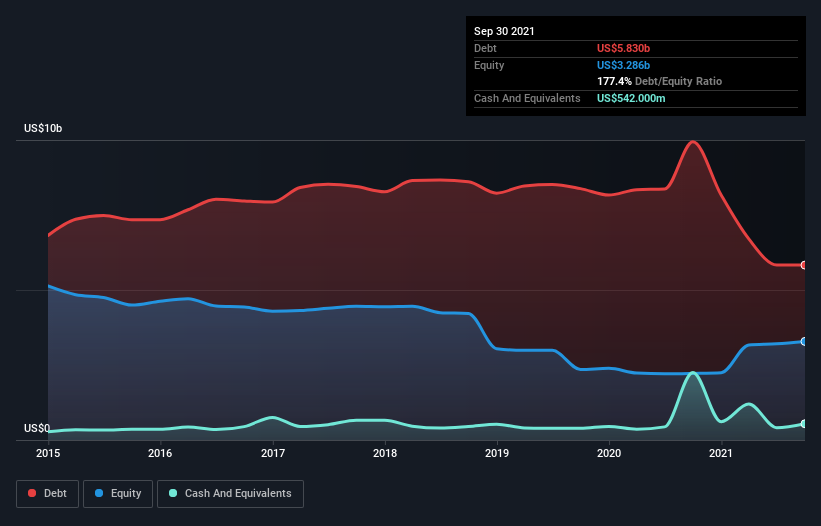- United States
- /
- Professional Services
- /
- NYSE:NLSN
These 4 Measures Indicate That Nielsen Holdings (NYSE:NLSN) Is Using Debt Extensively

Howard Marks put it nicely when he said that, rather than worrying about share price volatility, 'The possibility of permanent loss is the risk I worry about... and every practical investor I know worries about.' It's only natural to consider a company's balance sheet when you examine how risky it is, since debt is often involved when a business collapses. As with many other companies Nielsen Holdings plc (NYSE:NLSN) makes use of debt. But the more important question is: how much risk is that debt creating?
When Is Debt Dangerous?
Generally speaking, debt only becomes a real problem when a company can't easily pay it off, either by raising capital or with its own cash flow. Ultimately, if the company can't fulfill its legal obligations to repay debt, shareholders could walk away with nothing. However, a more common (but still painful) scenario is that it has to raise new equity capital at a low price, thus permanently diluting shareholders. Of course, plenty of companies use debt to fund growth, without any negative consequences. The first step when considering a company's debt levels is to consider its cash and debt together.
View our latest analysis for Nielsen Holdings
What Is Nielsen Holdings's Net Debt?
As you can see below, Nielsen Holdings had US$5.83b of debt at September 2021, down from US$9.94b a year prior. However, because it has a cash reserve of US$542.0m, its net debt is less, at about US$5.29b.

How Strong Is Nielsen Holdings' Balance Sheet?
According to the last reported balance sheet, Nielsen Holdings had liabilities of US$826.0m due within 12 months, and liabilities of US$7.06b due beyond 12 months. On the other hand, it had cash of US$542.0m and US$616.0m worth of receivables due within a year. So its liabilities outweigh the sum of its cash and (near-term) receivables by US$6.73b.
This deficit is considerable relative to its market capitalization of US$7.42b, so it does suggest shareholders should keep an eye on Nielsen Holdings' use of debt. Should its lenders demand that it shore up the balance sheet, shareholders would likely face severe dilution.
In order to size up a company's debt relative to its earnings, we calculate its net debt divided by its earnings before interest, tax, depreciation, and amortization (EBITDA) and its earnings before interest and tax (EBIT) divided by its interest expense (its interest cover). The advantage of this approach is that we take into account both the absolute quantum of debt (with net debt to EBITDA) and the actual interest expenses associated with that debt (with its interest cover ratio).
With a net debt to EBITDA ratio of 5.1, it's fair to say Nielsen Holdings does have a significant amount of debt. However, its interest coverage of 2.6 is reasonably strong, which is a good sign. On the other hand, Nielsen Holdings grew its EBIT by 27% in the last year. If sustained, this growth should make that debt evaporate like a scarce drinking water during an unnaturally hot summer. There's no doubt that we learn most about debt from the balance sheet. But ultimately the future profitability of the business will decide if Nielsen Holdings can strengthen its balance sheet over time. So if you're focused on the future you can check out this free report showing analyst profit forecasts.
Finally, while the tax-man may adore accounting profits, lenders only accept cold hard cash. So it's worth checking how much of that EBIT is backed by free cash flow. During the last three years, Nielsen Holdings produced sturdy free cash flow equating to 62% of its EBIT, about what we'd expect. This cold hard cash means it can reduce its debt when it wants to.
Our View
Neither Nielsen Holdings's ability handle its debt, based on its EBITDA, nor its interest cover gave us confidence in its ability to take on more debt. But its EBIT growth rate tells a very different story, and suggests some resilience. We think that Nielsen Holdings's debt does make it a bit risky, after considering the aforementioned data points together. Not all risk is bad, as it can boost share price returns if it pays off, but this debt risk is worth keeping in mind. There's no doubt that we learn most about debt from the balance sheet. But ultimately, every company can contain risks that exist outside of the balance sheet. For example Nielsen Holdings has 2 warning signs (and 1 which is a bit unpleasant) we think you should know about.
Of course, if you're the type of investor who prefers buying stocks without the burden of debt, then don't hesitate to discover our exclusive list of net cash growth stocks, today.
Valuation is complex, but we're here to simplify it.
Discover if Nielsen Holdings might be undervalued or overvalued with our detailed analysis, featuring fair value estimates, potential risks, dividends, insider trades, and its financial condition.
Access Free AnalysisHave feedback on this article? Concerned about the content? Get in touch with us directly. Alternatively, email editorial-team (at) simplywallst.com.
This article by Simply Wall St is general in nature. We provide commentary based on historical data and analyst forecasts only using an unbiased methodology and our articles are not intended to be financial advice. It does not constitute a recommendation to buy or sell any stock, and does not take account of your objectives, or your financial situation. We aim to bring you long-term focused analysis driven by fundamental data. Note that our analysis may not factor in the latest price-sensitive company announcements or qualitative material. Simply Wall St has no position in any stocks mentioned.
About NYSE:NLSN
Nielsen Holdings
Nielsen Holdings plc, together with its subsidiaries, operates as a measurement and data analytics company worldwide.
Solid track record and good value.
Similar Companies
Market Insights
Community Narratives



